Table of Contents
- Stages of designing ponds and artificial reservoirs
- What does the pond or reservoir project include
- Designing different types of ponds and reservoirs: features and examples
- Design prices
Owners of suburban land plots, especially those with a large area, often have a desire to equip the territory with the help of an artificial pond. Such a design can perform a decorative or economic function, and also noticeably enlivens the area and gives it a special grace.
However, in order to equip a pond or other artificial reservoir on a house, city, or, for example, the territory of a cottage settlement, it is first necessary to draw up a construction project that will include information about the climatic features of the area, about the characteristics of the soil, about all the nuances of the arrangement of the reservoir and many other data. In this article, we will discuss how to design properly a pond and what is necessary for this.
Stages of designing ponds and artificial reservoirs
The process of developing an extensive plan for the future artificial reservoir includes four main stages. Let’s look at each of them in more detail.
- A comprehensive study of the territory. Before proceeding to the design of an artificial reservoir, it is extremely important to conduct a qualitative and, most importantly, a comprehensive analysis of the land plot on which the installation of the structure is planned. To do this, geodetic expertise is ordered from professionals, designed to study the features of the soil and ground.
Other studies should determine the location and intensity of groundwater, the depth of their freezing, and the likelihood of flooding of the site. It is equally important to comply with all the requirements for the location of the pond regarding utilities, sewer elements, and drainage system. It is not recommended to install an artificial reservoir directly above the central collector gathering water from the entire territory.
It is highly desirable to conduct an environmental survey of the area, according to the results of which it will become known how safe it is to install a swimming pond or a pond intended for fish breeding on a specific territory. - Definition of the pond concept. The next stage of work involves the formation of a full-fledged pond concept. It should be created taking into account the results of all studies, landscape solutions, and the wishes of the owner of the suburban area. It would be best to start by determining the location of the pond on the territory, its purpose, and, of course, the shape.
Do not forget to design the decorative project of the pond, at the stage of creation of which you can give space to imagination. Around an artificial pond, you can lay out tiles, natural or artificial stone, put plants, as well as install benches, gazebos, fountains, waterfalls, and other design elements that can give the pond and coastal areas uniqueness.
At this stage, it is recommended to make drawings or sketches that will make the desires more realistic. - Design of the necessary treatment facilities. In order for the constructed reservoir to function without interruptions, and the water in it does not begin to bloom, silt up and smell bad, it is necessary to take into account special installations and filters through which pond water will circulate and be purified in the project.
- Collecting the necessary documentation. An artificial reservoir, as a hydraulic structure in accordance with the requirements for such structures. The design documentation includes schemes of lines and communication nodes, the profile of the reservoir bowl with the mandatory indication of heights, schemes for creating the base of the reservoir and laying waterproofing, the location of cleaning filters, as well as a center drawing and additional sketches created at the request of the owner of the land plot.
On the basis of the listed documents, the necessary equipment is prepared and all materials are purchased in the right quantities, and the duration and final cost of the installation and arrangement of an artificial reservoir are determined.
A well-designed project will allow you to avoid unforeseen situations, offensive mistakes and any other inaccuracies at the construction stage.
What does the pond or reservoir project include
A competent pond or artificial pond project necessarily includes the elements necessary for the correct and safe installation of the reservoir. The list of such elements includes:
- Determination of the area, shape, and depth of the reservoir;
- Determination of the material from which the mold will be made;
- Location of engineering systems on the territory selected for the reservoir;
- Zoning of the reservoir and determination of dam zones and zones of the location of pond plants;
- Format of a drainage system, filters, and water purification system in a pond or reservoir;
- Installation of electronics necessary for the functioning of the reservoir;
- Defining the rules of pond care and all seasonal activities;
- Drawing up a landscape plan and recreation areas;
- Decoration of the bottom of the reservoir and coastal areas with vegetation and other decorative elements.
The most difficult moment at the design stage is the calculation of drainage and filtration systems, as well as the design of the landscape.
Let’s talk about these aspects in more detail.
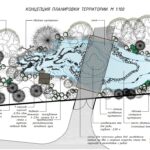
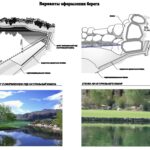
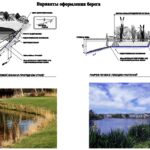
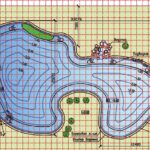
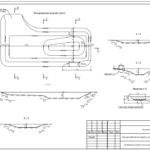




Artificial reservoir drainage system
It is recommended to equip each artificial reservoir with a reservoir-type and ring drainage system designed to divert water from the pond territory. As a rule, drainage collects groundwater from under the pond and does not allow the upper water to destroy its coastline.
Sometimes drainage protects buildings around a pond or reservoir from getting water from it into the area of the underground parts of buildings and structures. Water, as a rule, is diverted to the main collector, which is connected to the stormwater or central sewer. A high-quality system protects the land from flooding and ensures safety and comfort of operation even during heavy rainfall.
Since the drainage system is rather complex element of the territory, including internal and external rain collectors, underground trenches downpipes and a considerable number of wells, it should be designed in advance.
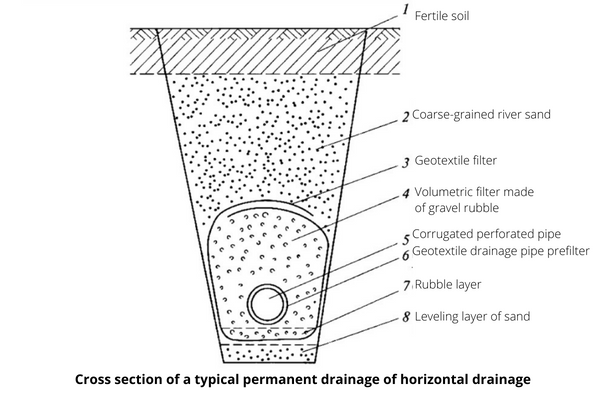
Water filtration system
A good cleaning filter is necessary for almost any reservoir, regardless of its purpose. The filtration system prevents turbidity, blooming and silting of the water filling the pond. To date, there are three types of filters:
- Mechanical filters free water from debris and suspended solids. Cleaning is carried out only when the liquid passes through the filters.
- UV filters kill algae and harmful microorganisms contained in water with the help of ultraviolet rays.
- Biological filters. Their work is based on the ability of bacteria to eat harmful substances contained in the liquid.
Depending on the purpose of the reservoir, a decision is made to install one or another filter. For swimming ponds, as well as for ponds in which fish are bred, it is best to choose a comprehensive cleaning system that combines several types of filters at once. Modern manufacturers offer filters capable of purifying large volumes of water with high efficiency. It is also recommended to choose a company that manufacturers filters at the stage of drafting the project.
As a rule, the elements of the cleaning system are installed on the surface of the ground and decorated with plants, stones, bridges and other decorations. When installing filters, it is important to consider whether they are pressure or not. Pressure filters are sealed and can be installed below the water level, and this possibility is not provided for non-pressure filters that are not protected from moisture.



Scheme of operation of filters for water purification in a pond

Landscape design and design of recreation areas
At the stage of choosing the design of decorations that will decorate the pond and adjacent territories, you can give space to your imagination. The reservoir itself is formed with the help of swamp, coastal, deep-sea (buoyant), underwater and other plants. A skillful combination of different types of vegetation will give the artificial pond a unique appearance.
If the pond is large enough, a small bridge can be thrown over its surface or wooden “water lilies” can be fixed on the surface of the water, also used as entertainment. Decorative streams, fountains, small waterfalls and artificial alpine slides are often included in the landscape project.
Landscape design also includes the planning of recreation areas. They can include benches, gazebos, hammocks and other design solutions. To the pond, located in the depths of the garden, you can spend winding paths that will add a little mystery and romanticism.
Often, an artificial pond is decorated with figurines, for example, garden gnomes, or equipped with decorative lighting, which also needs to be included in the project. However, it is important to remember that when taking care of the reservoir, we should not forget about the decorations, which also need regular treatment.











Designing different types of ponds and reservoirs: features and examples
The design of various types of ponds and artificial reservoirs has its own characteristics. The differences are based on the purpose of the reservoir, its shape, size and many other characteristics. Therefore, to draft a specific reservoir, it is important to know all the nuances of its arrangement. Let’ talk about this in more detail.
Decorative ponds
Ponds, that perform only a decorative function are characterized by naturalness. Such reservoirs can perfectly fit into the overall picture of the site and decorate the garden. For decorative ponds, it is recommended to choose the most natural forms, that is, it would be best to abandon intricate shapes and ideal geometry. The bottom and coastal areas are formed with the help of natural vegetation that grows directly from the ground. Often, aquatic animals settle in a such a pond which make the pond even more attractive.
The design of decorative ponds includes the study of the territory, the preparation of the pit and the design of bottom. For such solutions, ready-made plastic molds, film materials, as well as PVC membranes and concrete bowls are used. An important point at the design stage of the pond is the installation of a filtration system, as well as its external design. If desired, you can decorate the pond with a small fountain or waterfall.
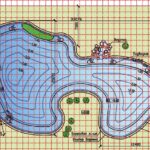







Fish ponds
Artificial ponds intended for fish breeding are designed taking into account the fact that they will be inhabited by living creatures. The water filling such a pond should comply with all sanitary standards and be favourable for fish habitat. Therefore, it is necessary to place such a reservoir on soil free of harmful chemicals. High-quality waterproofing of the pond bottom will limit the contact of the liquid with the soil.
It is also important to understand that fish need a place to live in the winter season. They can be relocated to a safe place for a cold period or leave the pond filled, but at the same time cover it with a film and at the same time provide oxygen inside. Oxygen is needed for the reason that rotting plants can be disastrous for fish trapped under a layer of ice. Therefore, it is extremely important to take into account all seasonal activities carried out with the pond at the stage of drafting.
It will not be superfluous to install a filtration system that will the fish to feel more comfortable. And also, at least once every few months, it is necessary to order an examination from specialists who can detect diseases of fish. Seasonal vitamin deficiency, plant rot and other factors can negatively affect the health of pond inhabitants. The sick fish is isolated from the rest until their further interaction becomes possible.





Swimming ponds
One of the most responsible processes is the design of swimming pools. They should be equipped with a filtration system, a drainage system connected to storm sewer, various decorative elements that are safe for the health of bathers, as well as a pleasant-to-touch coating of the bottom. It is safest to install such reservoirs just above the surface of the ground: this eliminates the risk of a person accidentally falling into the water.
The shoreline of the pond intended for swimming is necessarily reinforced with a fastening tape, which has hydrophobic properties and not subject to rotting. Stakes are driven along the perimeter of the reservoir, and a tape is fixed to them using screws. Most often a layer of geotextile is laid on the bottom, and on top of it is covered— with butyl rubber film, which is covered with any natural material, for example, sand or pebbles.
For swimming reservoirs, it is best to choose filters that carry out complex filtration.



Design of a fire pond
The fire pond refers to the elements of the territory that perform an exclusively economic function. Therefore, such a technical reservoir can be located both underground and on its surface. At the design stage of fire reservoirs, it is necessary to mark the future pond, remove the top layer of soil and dig a pit, which will serve as the shape of the pond.
It is also important to design a drainage system that will free the territories adjacent to the pond from excess fluid. The bottom of the pit is released from roots, vegetation and other surface elements that prevent the installation of waterproofing. Sand cushion, fiberglass and sealing membrane are used as hydrophobic compounds. Filling the pit with water begins with pouring liquid one-third of its volume. Filling too sharply may cause damage to the waterproofing surface.

Design of artificial ponds
Such ponds can have absolutely any shape, from strict geometric to one that consists of arbitrary lines, they are allowed to be decorated using any decorative elements ranging from natural stone or marble figurines, as well as artificial reservoirs can combine elements of opposite styles.
Artificial reservoirs can be carried out using mobile or stationary water. The movement of the liquid is ensured by the height difference, which is necessarily taken into account at the design stage of the reservoir, as well as by installing fountains, artificial waterfalls and other design solutions. It is important to take into account at the design stage the issue of installing pumps designed to collect water in the lower part and divert it to the beginning of the fluid flow.
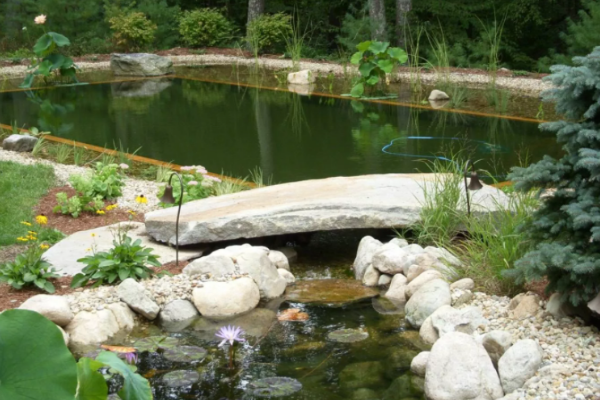

Design of water structures
It is recommended to plan various water structures, such as fountains, streams, cascades and waterfalls, together with a professional in this field. The specialist will help to determine the right place for the installation of the structure, develop the technology of its functioning, calculate the number of required materials and, as a result, will help to allocate funds correctly.
For water structures, it is customary to use filters, such as, for example, ultraviolet, biological or standard mechanical. Also, the design involves the development of a plan for laying out hoses under the ground’s surface, installing a drainage system and installing pumps that collect liquid and deliver it to the place where the water begins to move.
In order not to make unpleasant mistakes, that can lie in wait at every step, it is recommended to apply for a professional help.






Design of storage ponds
A separate type of ponds — storage-ponds are intended to perform an economic function. The design of such reservoirs also begins with a comprehensive study of the terrain, drawing up a pond concept and determining the number of necessary materials and equipment items. After that, the plot of land is released from vegetation and stones, and a pit is torn out in its place.
The construction of such a pond supposes the use of materials, filters and other systems that were determined at the design stage, and the filtration system is selected taking into account the chemical composition of the soil. Then the pit if filled with water, the design of the bottom and coastal areas is carried out, as well as the putting of plants around the storage pond.

For more information and recommendations on the construction of ponds, you can find in the following articles:
- Construction of artificial reservoirs and ponds: Installation technology with step-by-step instructions
- Waterproofing of ponds and reservoirs: Methods and materials
Design prices
| Names of project works | Price |
| – Master plan for the entire surface area of the mirror of the reservoir with the application of design marks of the depth of the shelves; – Technological cross sections of the reservoir – the profile of the basin of the reservoir with elevation marks; – Summary table on the volumes of material used; – Scheme of preparation of the base and laying of the waterproofing layer; – A table indicating the timing of the work on the implementation of the project; – Estimated calculation; | starting from 2000 roubles |
| – Development of a water filtration and reservoir purification system; – Calculation of equipment parameters and characteristics; – – Specification of pumping and filtering equipment; – Development of water intake, water treatment, spillway and water balance systems; – Layout of equipment; – Structural nodes of laying communications; | starting from 1200 roubles |
| Cascade project | starting from 600 roubles |
| Landscape and plant planting project | starting from 450 roubles |
| Development of operations for the future water complex | starting from 300 roubles. |









